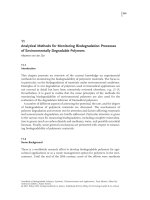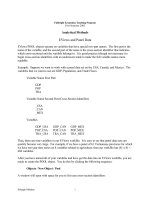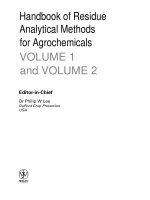Analytical methods 1998
Bạn đang xem bản rút gọn của tài liệu. Xem và tải ngay bản đầy đủ của tài liệu tại đây (4.88 MB, 6 trang )
Chapter 9
Analytical Methods
Analytical methods for fats and oils are manifold and important also to understand
their technology. To describe them in detail goes far beyond the scope of this book.
Because references were made to certain methods in the text, an overview of key
methods is included in this chapter. For a more detailed view, see the Official Methods
and Recommended Practices of the American Oil Chemists' Society, and other books
on the analysis of fats and oils published by AOeS Press. See also the European
equivalent of the AOeS methods published by the German Society for Fat Research
(DGF). Both the AOeS and DGF method numbers are referenced.
The acid value determines the amount of free fatty acids in a fat. Usually the sample
which is dissolved in a solvent (AGeS method: isopropyl alcohol/toluene; DGF
method ethanol/ether) is titrated with 0.1 N potassium hydroxide solution against phenolphthalein. In practice, for instance in refinery day-to-day operation, KOH may be
replaced by the cheaper NaOH.
Acid
I
Cl va ue
N .56.1
(S - B)
=-,W
[9.1]
where S is the standard alkali used for titration of the sample (ml.), B is the standard alkali used for titration of the blank (ml.), N is the normality of the standard
alkali and W is the weight of sample (g).
Methods: AOeS: Cd 3a-63; DGF: C-V-2
9.2 Saponification Value
The saponification value is the amount of alkali (in this case mg of potassium
hydroxide) required to saponify a definite quantity of fat or oil. As all fatty acids
"bind" one molecule of potassium hydroxide, the saponification value also indirectly is a measure for the average molecular weight of the triglycerides of a fat
and therefore a characteristic number.
The fat is saponified with an excess of alcoholic potassium hydroxide.
Titration with HCI indirectly delivers the amount of KOH consumed.
(B-S)·N·56.1
Saponlification va Iue = ----W
[9.2]
where S is the 0.5 N HCI solution required for titration of the sample (mL), B is the
803
Fats and Oils Handbook
804
0.5 N HCI solution required for titration of the blank (mL), N is the normality of
HCI solution, and W is the weight of sample (g).
Methods:
AOCS: Cd 3-25, Cd 3b-76; DGF: C-V-3
9.3 Iodine Value (IV)
The iodine value is a measure for the average number of double bonds of a fat or
oil. Double bonds add halogen, with each double bond consuming 1 mol of halogen. The average number of double bonds can then be concluded from the halogen
consumption (here: iodine). The addition of iodine is not quantitatively; thus the
results of the analysis depend on the method chosen to allow a comparison of different samples.
The traditional method uses chloroformium or carbon tetrachloride (both
toxic) as a solvent. The fat sample is dissolved in the solvent; then a fixed amount
of iodine solution is added. After a reaction time of around ,...,30 min, the excess
iodine is titrated with sodium thiosulfate solution and thus the amount of iodine
consumed is indirectly measured.
(S-B)·No12.69
[9.3]
----IodiIne vaI ue = W
where S is the thiosulfate solution for back-titration of sample (mL), B is the thiosulfate solution for back titration of blank (mL), N is the normality of thiosulfate
solution, and W is the weight of sample (g).
The Wijs-method uses an 0.2 N acetic acid/carbon tetrachloride solution as a
solvent. A reaction time of 1 h (high IV) to 2 h (low IV) is then needed. More
recently the above method has been replaced by others in order to avoid the usage
of toxic solvents.
Methods: AOCS: Cd 1-25, Cd 1b-87 and Cd 1d-92; DGF: C-V-11a and b
9.4 Peroxide Value (POV)
The peroxide value of a fat reflects the degree of its oxidation taking place. There
usually are legal or quality limits for the POV. All substances that oxidize potassium iodide under the reaction conditions are determined by this method.
POV
= _(S_-_B_)_oN_o_10_0_0
W
[9.4]
where S is the titration of sample (mL), B is the titration of blank (mL), N is the normality of thiosulfate solution, and W is the weight of sample (g).
Methods: AOCS: Cd 8-53 and Cd 8b-90; DGF: C-VI-6
Analytical Methods
805
905 Unsaponifiable Matter
Unsaponifiable matter consists of those substances that are found dissolved in fats
and oils and cannot be saponified by the usual caustic treatment. These substances
are soluble in fats and oils. These components comprises for instance higher
aliphatic alcohols, sterols, pigments and hydrocarbons.
. .
R-(B+F)·100
Unsaponifiable matter == - - - - - W
[9.5]
where R is the weight of residue (g), F is the weight of fatty acid (g), B is the
weight of blank (g), and W is the weight of sample (g).
Methods: AOCS: Ca 6a-40 and Ca 6b-53; DGF: C-III-la and C-III-ib
9.6 Water Content
Karl Fischer reagent reacts quantitatively with water. The fat is dissolved in
methanol (H2 0 < 0.05% w/w) and titrated with the reagent.
H?O == (5 - B)· X ·1000 (% wt/wt)
-
2
[9.6]
where 5 is the Karl Fischer reagent titration of sample (mL), B is the Karl Fischer
reagent titration of blank (mL), X is the water equivalent of Karl Fischer reagent
(mg), W is the weight of sample (mg), and
[9.7]
where l1ZH20 is the amount of water added for calibration of Karl Fischer reagent
(mg), V is the Karl Fischer reagent titration of added water (mL), and Vb is the Karl
Fischer reagent titration of blank (mL).
Methods: AGCS: Ca 2e-84; DGF: C-III-13a
907 Phosphorus Content
The sample is ashed in the presence of zinc oxide, followed by spectrophotometric
measurement of phosphorus as a blue phosphomolybdic acid complex.
Methods: AOeS: Cd 12-55; DGF: C-III-16a
806
Fats and Oils Handbook
9.8 Colorimetric Value
Several methods to determine color exist. Most of them are based on a comparison of
the oil with permanent color standards. The German methods use differently concentrated solutions of inorganic colored salts as standards. To prepare a dichromate standard solution, 0.736 g of potassium dichromate are dissolved in water to 1000 rnL.
This solution, by definition, possesses the grade 20". Diluting it to l/x yields the color
grade 20/x. The standard iodine color is prepared by dissolving 10 g of iodine and 100
g of potassium iodide with water to 1000 mL (iodine color 1000).
To determine the "Lovibond color," an oil sample is compared with a reflection body of magnesia that is lighted through filters by two sources of light. The
color added from the two light beams has to be equal to the color of the sample. As
a result of the measurement the color grades from the two light sources and the
thickness of the oil cuvette are obtained.
Methods: AGCS: Cc 13a-43, Cc 13b-45 and Cc 13c-50; DGF: C-IV-4
9.9 Hexane in Extraction Meal
9.9.1 free Hexane
This method determines the sum of volatile residual hydrocarbons in extraction
meal by heating the sample to 80°C after addition of an internal standard in a
closed vessel. After a calibration curve is developed, the hydrocarbons are then
determined by headspace analysis by means of gas chromatography using capillary
or packed column. Results are expressed as hexane in ppm.
9.9.2 Total Hexane
This method determines the sum of volatile residual hydrocarbons in extraction
meal by heating the sample with water in a closed vessel to 110°C. After a calibration curve is developed, the hydrocarbons are then determined by headspace analysis by means of gas chromatography using capillary or packed column. Results are
expressed as hexane in ppm.
Methods: AGCS: Ba 14-87; DGF: B-II-8a
9.10
Crude Fiber in Meal
This method determines as crude fiber the loss on incineration of a pretreated sample. The pretreatment is carried out by digestion with dilute sulfuric acid and dilute
sodium hydroxide, filtration, washing and, drying.
Crude fiber = (S - B) ·100 (% wt/wt)
W
[9.8]
807
Analytical Methods
where S is the loss in weight from incineration of the sample (g), B is the loss in
weight from incineration of the blank (g), and W is the weight of sample (g) .
Methods: AOeS: Cd 8-53 and Cd 8b-90; DGF: C-V 1-6
9811 Protein in Meal
Protein in the meal is determined as 6.25 times the nitrogen content of the sample.
Nitrogen is determined by the Kjeldahl method. The sample is heated with sulfuric
acid. The ammonia is released from the ammonium sulfate that is formed by means
of caustic soda solution. It is absorbed in excess sulfuric acid which is titrated back
with alkali solution.
·
N itrogen
= (B -
S)· N· 0.014 ·100 (01
W
-/0
t/ t)
W W
[9.9]
where S is the alkali back titration of sample (rnL), B is the alkali back titration of
blank (ml.), N is the normality of alkali solution, and W is the weight of the sample
(g).
Methods: AGCS: Ba 4a-38, Ba 4b-37, Ba 4c-87 and Ba 4d-90; DGF: B-II-6
9.12 Ash
The ash residue after incineration is determined. Incineration is carried out at 600 ±
15°C in the AGCS method and 550 ± 15°C in the DGF method. The ash content is
given as % wt/wt of the incinerated oil/fat.
A·100
Ash = - - (% wt/wt)
W
[9.10]
where A is the weight of ash (g) and W is the weight of sample (g).
Methods: AGeS: Ba 5a-49; DGF: B-II-5
9.13 Solid Fat Content
The quantity of solid glycerides is measured by means of pulsed NMR (van den
Eyden 1982). Standardized olive oil samples are used as a reference. The sample is
completely melted, brought to measuring temperature, inserted into the NMR and
measured at 60°C and at the desired temperature after 30 min of equilibration.
The mechanism uses the fact that resonance signals can only be obtained from
hydrogen molecules that are in the liquid state. NMR equipment is not the high reso-
808
Fats and Oils Handbook
lution apparatus that is used to solve problems of chemical structure but low resolution. Solid Fat Content (SFC) is then determined by the following calculation:
SFC == Reference oil at 60° x Sample at T
Sample at 60°
Reference at T
[9.11]
where T is the measuring temperature (OC).
Methods: AOCS: Cd 16-81; DGF:
9.14 Dilatation; Solid Fat Index (SFI)
The solid fat index is an empirical measure of the solid fat content, using dilatometrie of a fat/oil. An indicator solution (1 % aqueous potassium dichromate) is deaerated, as well as the sample that is heated to 80°C. Indicator solution (2 mL) is
weighed into the dilatometer bulb. Then the indicator is carefully overlayed with
the sample until it overflows. The contents of the dilatometer are then transferred
one after the other into water baths and allowed to equilibrate. The reading from
the expansion are recorded.
SFI(T) == D, - [E· (60 - T)]
[9.12]
with SFI(T) is the solids fat index at measuring temperature T (OC), D, is the total
dilatation (mL/kg between T and 60°C), and E is the thermal expansion.
[9.13]
with R T is the dilatometer reading at T, VCT is the volume correction for instrument expansion (read from tables), and W is the weight of sample.
Methods: AOCS: Cd 10-57; DGF: C-IV 3
9.15 Analysis of lipids
For analysis of lipids, see, for example, Hamilton and Rossell (1986), Christie
(1982), and Pardun (1976) as well as the relevant AOCS and DGF methods.









